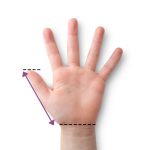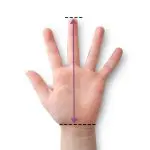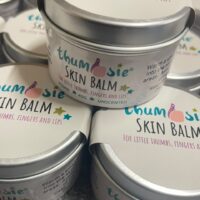In this blog, Thumbsie® provide a detailed analysis of thumb sucking and highlight a range of key statistics from organisations such as the British Orthodontic Society, the American Dental Association, the Mayo Clinic and Colgate.
If you’re reading this, the chances are that you’re concerned about your child’s thumb sucking.
You probably have lots of questions: Is thumb sucking bad? What is the psychology of thumb sucking? What are the long-term effects? And what about adult thumb sucking: is that a problem too?
These are all important questions. And don’t worry, we have the answers.
Psychology of thumb sucking
Thumb sucking often starts in the womb as a natural reflex. Indeed, it is one of the most common habits during childhood.
It is normal for an infant up to the age of 3 or 4 to want to suck their thumb.
The National Institute of Health (NIH) in the USA states that “approximately 50 percent of infants at one year of age suck a thumb or finger.” They also note that the average age at which the habit stops is 3.8 years of age.
One in every eight children (aged 7-11) have a prolonged digit sucking habit, according to the British Orthodontic Society. Girls are more likely to be prolonged digit suckers than boys. Unfortunately, this is a habit that can stretch into adulthood. Leading health website Healthline, has stated that there is evidence as many as one in every ten adults suck their thumbs. Again, the habit seems to be more common in women than men.
Where the habit extends beyond the age of 7, when the adult teeth start to appear, problems with the position and function of teeth can emerge.
The psychology behind thumb sucking is relatively simple and is the same for both children and adults. The habit is typically a soothing mechanism that provides security and comfort, like being in a mother’s womb. Once the person starts to associate thumb sucking with anxiety relief and comfort, then it gradually becomes a learned behaviour which is hard to break.
Long-term effects of thumb sucking
The long-term effects of thumb sucking are many and varied, but the most obvious are teeth and bite problems.
The key numbers to remember here are 6 and 7. The American Dental Association has noted that if a child sucks their thumb or finger for more than 6 hours per day, and they do so beyond the age of 7, then long-term damage to teeth becomes more likely.
So, what problems can occur?
- Anterior open bite: Where the incisor teeth of upper and lower jaws are not well placed when closing the mouth. This can then make biting certain foods very difficult. An anterior open bite is by far the most common side-effect of prolonged thumb sucking. A study by The National Institute of Health showed that 50 per cent of thumb sucking 3-year-olds were developing an anterior open bite.
- Crossbite: Improperly aligned teeth that have been pushed forward and upward. This happens when the upper jaw narrows and the back teeth are in the incorrect position.
- Speech problems: Due to irregularity of the teeth, speech problems such as lisping, imprecise pronunciation and thrusting out the tongue when talking can occur.
- Roof of mouth: The shape of the roof of the mouth can be dramatically changed and may narrow.
- Overbite/overjet: The upper front teeth may stick out prominently.
These dental problems can be significant and long-lasting. The child may require orthodontic treatment (braces) in the future to attempt to correct the tooth position. However, orthodontic treatment cannot be started until the habit has completely stopped.
It is not just teeth that can demonstrate the long-term effects of thumb sucking.
Another common sign of a thumb sucking habit is chapped skin or wounds on the thumb. Constantly sucking on a thumb may cause irritated and dry skin. Wounds can also appear around the mouth, which in addition to being unsightly can also be prone to infection.
Other associated problems include:
- Hair pulling or twirling (Trichotillomania) which can cause loss of hair. Academics in Australia and the US have studied and confirmed the links between hair pulling and thumb sucking.
- Social anxiety due to the perceived negative status of a thumb sucker – particularly as the child grows older. Children can be cruel, and there are reports of youngsters being bullied by their peers for thumb sucking.
Is thumb sucking bad?
Children self-soothe in many ways, including hugging stuffed animals and carrying a favourite blanket. If your child has grown fond of thumb sucking, there is usually no cause for concern as it is totally healthy and typical behaviour in most cases. As noted above, the problems start to emerge when the habit continues beyond the age of 3 or 4, and especially beyond the age of 7. This should be avoided if at all possible.
Once adult teeth start to develop, the habit of thumb sucking becomes much more alarming – and the damage caused can be irreversible.
Some experts, such as at the Mayo Clinic, recommend addressing sucking habits before the age of 3, while others say treatment is usually limited to children who continue thumb sucking after turning 5.
Breaking the thumb sucking habit
We want children to have fun whilst trying to break the thumb sucking habit. Over time Thumbsie® can help a child break the thumb sucking habit. Buy NowHow to stop thumb sucking?
Thumb sucking is not an easy habit to break. If it were, Thumbsie® wouldn’t exist!
Experts at Colgate say that if you can go for 30 days without sucking your thumb, the habit will be completely broken. But as a rule, the key to breaking the habit is to go back to the root cause: security. Because a child is seeking comfort and security, they turn to thumb sucking as an immediate relaxant and soothing technique. In order, to break the habit, it is important to try and find out what the child is worried about. It could be a new house move, or a new school, or even a new sibling. It is important to remember that this is very rarely the parent’s fault. Every one of us has coping mechanisms which manifest themselves in different ways. Thumb sucking is merely another form of coping mechanism.
There are a number of different methods for helping a child overcome thumb sucking, but one useful approach is to encourage, reward, avoid and remind.
Encourage: It is important to continue encouraging your child and praising them when they do well. Show them that you want to listen and help them to end their sucking habit.
Reward: At Thumbsie®, we are strong proponents of a rewards system. Breaking the thumb sucking habit can be very difficult, which is why we believe it should be made as fun as possible. We offer a rewards chart and stickers which can help to set targets and to reward a child when they have gone an hour, a day or even a week without sucking their thumb.
Avoid: Although it can be frustrating when a child has a thumb sucking habit, it is important to avoid nagging the thumb sucker, and you should never punish them. It is always much better to be positive and to attempt to build up their self-esteem.
Remind: For some children the only way to finally break the habit is through a “reminder” or physical barrier. According to the British Orthodontic Society this could be an elastopast, a bandage or a glove. But, by far our preferred option is a fabric thumb guard.
Thumb guards are recommended by a wide range of oral health experts, including the American Dental Association, the Mayo Clinic and Colgate.
Best of all, we have an excellent 4.8 out of 5 stars on Google Reviews, showing that our most important audience – mums and dads – are delighted with the effectiveness of our thumb guards.
More questions you may have – Does thumb sucking run in families and is there a significant sex difference in thumb sucking.
Fabric Thumb Guards
Worn day and night a Thumbsie® thumb guard can help your child to stop thumb sucking Buy NowWhy a Thumbsie® may be the answer
At Thumbsie®, we produce highly popular and effective thumb guards designed to be both fun and to help a child break the thumb sucking habit. We were founded 9 years ago and continue to go from strength to strength.
Thumbsies® are handmade and fit over the thumb like a glove for the prevention of thumb sucking in children.
The guard is secured around the wrist using Velcro. Thumbsie® comes in 5 different sizes, and we have a simple measuring guide, which helps the guards to fit well (they fit on either hand). The product covers the thumb and acts as a constant reminder when the thumb is placed in the mouth. We also offer finger guards which fit over the middle two fingers.
We are officially accredited by the Oral Health Foundation, demonstrating that our thumb guards have been independently endorsed by experts following rigorous scrutiny and testing on each item.
There are only 150 products globally which have made the Oral Health Foundation grade, so we are in elite company.
We have also won countless awards, including a MadeForMums award, Dental Industry award, Best Business Women award and Family Network National award.
Please note all comments will need to be approved before appearing on this page. Please respect others when posting.





























Comments